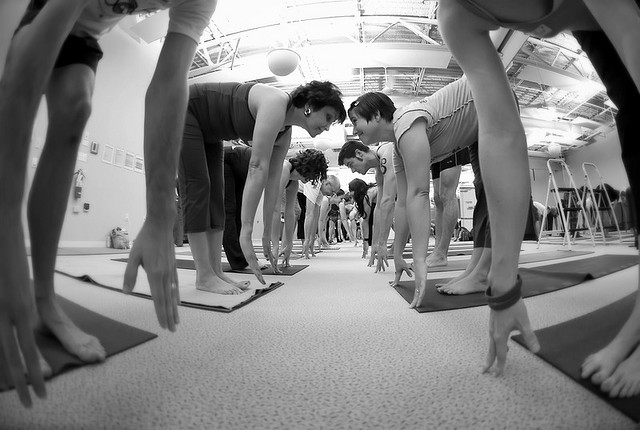Big Box Yoga.
Mainstream yoga.
Franchise yoga.
“It’s so…corporate,” the yogi whispers. “Sure, I occasionally go there, but the real yoga is happening at (insert name of small, financially unstable, ma and pop studio here).”
The multi-location heavyweights—be it YYoga, Yoga Works, Core Power, or Bikram Yoga—are often criticized for wolfing down market share from the “authentic” smaller studios that once held dominion over the yoga lineage. And while some yogis embrace the change (oh, to have showers, lockers, clean mats, tea lounges and infrared saunas), others snipe at the offering: “Those big box studios. It’s just not real yoga.”
So what is “real” yoga, anyway?
Despite its recent appointment of a “Minister of Yoga,”not even India can really say. Over the last three thousand years, the term “yoga” has described a dizzying range of practices and conflicting philosophies. And despite this recent, cheeky bid for ownership, yoga hasn’t always been high on India’s list of national treasures. Many of its practices (like tantra) were initially reviled by the Indian mainstream.
So where does that leave us on this side of the pond? Are we just paying for a Lululemon clad workout rather than spending the same money at the gym?
Not exactly.
Despite yoga’s complicated past, its practices have one common aim: liberation from suffering. And while North American yogis may show up at class to get longer hamstrings, a happier back, or a tighter ass, invariably they keep coming back for something else: “I feel calmer,” “I’m less bitchy,” “I’m just…happier.”
Yoga teachers—Ganesh bless them—are still managing to get the essential message across.
The mission of “big box yoga” is to bring yoga and its message to as many people as possible.
It’s true, we don’t look like an ashram: we eschew incense because some guests are allergic, we are wary of hands on assists and inversions because of lawsuits, we avoid naming our classes in Sanskrit because it’s alienating to newcomers.
And we have an elaborate, corporate structure so that we can continue creating shiny, cleanly appointed, box after box in cities across the country. Because we want the non-yogis to walk in our doors and feel like they’re at home. And we want them to come back.
Yes, there are problems with our cultural version of yoga.
North American practitioners are predominantly privileged, white, and materialistic. The yoga industry here is a strange, bastard child of our cultural heritage and yoga’s historical offerings. We don’t practice yoga in caves on tiger skins; we wear Lululemon, practice on $125 mats, drink $8 juices after class and accessorize with malas without realizing that they’re tools for meditation. We have a appropriated a cultural tradition without understanding its depth.
And yet…
Big Box yoga is our next best chance for a North American spiritual evolution.
If hitting up a Vinyasa Flow class in Kitsilano helps us to feel a little less road rage and snap less at our kids, that’s good. If we experience less anxiety and depression (yoga has been proven to reduce both), that’s good. If we have more capacity to respond rather than react when conflict arises, that’s good. If we realize that our essential spiritual identity consists of more than thoughts in our head, that’s good.
And while yoga may be an elitist practice now, these big boxes pave the way to making it increasingly accessible to less privileged communities.
And what about those smaller, more traditional studios? Will they be wiped out by the evil corporate empire?
Not at all. Rest assured: those mom and pop studios aren’t going anywhere. In fact, big box yoga may ultimately inspire a whole new generation of seekers to investigate these more traditional venues. Once they have gotten a taste for the practice, that is.
So, bring on Big Box Yoga. Bring on the North American spiritual revolution. One well-lit, over-packed, commercialized class a time.
~
Love elephant and want to go steady?
Sign up for our (curated) daily and weekly newsletters!
~
~
Author: Rachel Scott
Editor: Ashleigh Hitchcock







Read 1 comment and reply